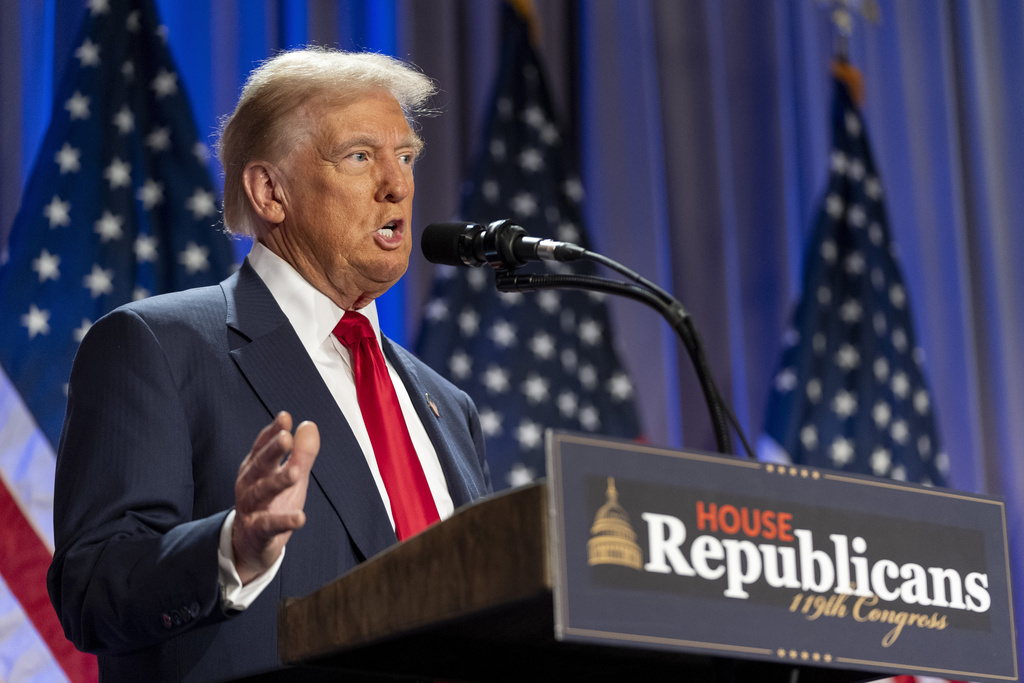Trump Threatens Tariffs on Mexico, Canada, and China \ Newslooks \ Washington DC \ Mary Sidiqi \ Evening Edition \ President-elect Donald Trump has announced plans to impose significant tariffs on Mexico, Canada, and China to address illegal immigration, drug trafficking, and fentanyl imports. These measures, set to take effect upon his inauguration, could disrupt international trade and challenge the U.S.’s trade relationships. Trump’s threats have drawn criticism as arrests at the southern border hit four-year lows.
Trump’s Proposed Tariffs on Top Trade Partners: Quick Looks
- Targeted Nations: Mexico and Canada face a 25% tariff, while China faces a 10% tariff increase.
- Immigration and Drug Issues: Trump ties tariffs to illegal immigration and fentanyl trafficking concerns.
- Border Statistics: Arrests at the U.S.-Mexico border are at a four-year low, contradicting Trump’s claims.
- Trade Deal in Question: Trump’s 2020 USMCA trade agreement could face uncertainty.
- Economic Impact: Tariffs would strain Canada and Mexico’s economies and complicate trade relations.
- Cabinet Input: Treasury nominee Scott Bessent backs tariffs as a foreign policy tool.
- Global Reaction: Canadian and Mexican officials have not formally responded to Trump’s threats.
Deep Look
Trump Threatens Sweeping Tariffs on Key Trade Partners
Details of the Proposed Tariffs
Trump’s proposed tariffs include a 25% tax on all imports from Mexico and Canada and a 10% increase on tariffs for Chinese imports. Trump declared these measures necessary to combat what he described as an “invasion” of illegal immigrants and drugs into the United States.
“On January 20th, as one of my many first Executive Orders, I will sign all necessary documents to charge Mexico and Canada a 25% tariff on ALL products,” Trump wrote. He claimed these actions would remain in place until illegal immigration and drug trafficking, particularly fentanyl, are stopped.
On China, Trump added: “Until such time as they stop [fentanyl trafficking], we will be charging China an additional 10% tariff on all of their many products coming into the United States of America.”
Contradicting Border and Drug Statistics
While much of America’s fentanyl is smuggled from Mexico, seizures of the drug have surged during President Joe Biden’s administration. U.S. officials reported intercepting 21,900 pounds of fentanyl in the 2024 fiscal year, compared to 2,545 pounds in 2019 when Trump was president.
Impact on Trade and the Economy
If enacted, the proposed tariffs could severely impact the economies of Mexico and Canada, the U.S.’s top trading partners. Canada and Mexico account for significant portions of U.S. imports, including automobiles, oil, and agricultural products.
Economists warn that higher tariffs could raise costs for American consumers, particularly for products like gasoline, vehicles, and food.
Cabinet Support for Tariffs
Trump’s treasury secretary nominee, Scott Bessent, is a vocal proponent of using tariffs as a foreign policy tool. Writing in a recent Fox News op-ed, Bessent stated:
“Whether it is getting allies to spend more on their own defense, opening foreign markets to U.S. exports, securing cooperation on ending illegal immigration and interdicting fentanyl trafficking, or deterring military aggression, tariffs can play a central role.”
Responses from Canada and Mexico
Canadian and Mexican officials have not yet issued formal statements on Trump’s threats. Canada’s Deputy Prime Minister Chrystia Freeland, who leads a Cabinet committee addressing U.S.-Canada relations, has previously expressed concerns about Trump’s trade policies.
A senior Canadian official, speaking anonymously, indicated that Canada anticipates Trump to act swiftly on trade and border issues after taking office.
Mexico’s Foreign Relations Department and Economy Department have also refrained from commenting, with the expectation that President Claudia Sheinbaum may address the issue during a morning press briefing.
Broader Implications
The proposed tariffs also reflect Trump’s reliance on bold, unilateral actions to leverage international cooperation, even as critics warn of the economic and diplomatic consequences.
As January 20 approaches, the global community will watch closely to see whether Trump follows through on his threats or uses them as a negotiating tool.
Trump Threatens







